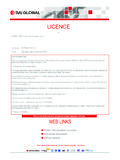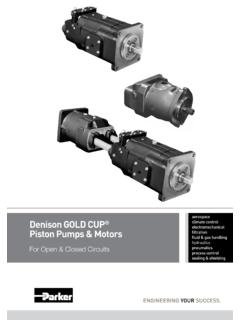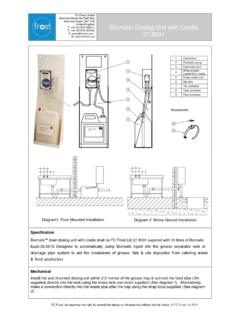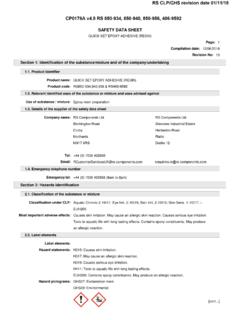Transcription of Safety Data Sheet - Like90
1 Like90 White Out SDS #: 8001 Safety data Sheet Section 1: Identification Product name: Like90 White Out Product number: 10032 (1-gallon), 10033 (5-gallon) Recommended use: Overspray protection for paint booth walls, doors, and other surfaces Manufacturer: Bonding Solutions, LLC 3703 West Parkway Blvd., West Valley City, UT 84120 USA Phone: +1 Email: Web: Emergency telephone: CHEMTREC Section 2: Hazard Identification United States According to OSHA 29 CFR HCS Classification: Skin Sensitizer: Category 3 Eye Irritation: Category 2B Label elements: WARNING (No pictograms required for label) Hazard statements: Causes mild skin irritation H316 Causes eye irritation H320 Precautionary statements Prevention: Avoid breathing dust/fume/gas/mist/vapors/spray.
2 P261 Wear protective gloves/protective clothing/eye protection/face protection. P280 Response: IF ON SKIN: Wash with plenty of soap and water. P302 + P352 If skin irritation or rash occurs: Get medical advice/attention. P333 + P313 IF IN EYES: Rinse cautiously with water for several minutes. Remove contact lenses, if present and easy to do. Continue rinsing. P305 + P351 + P338 If eye irritation persists: Get medical advice/attention. P337 + P313 Wash contaminated clothing before reuse. P363 Storage/Disposal: Keep container tightly closed. P233 Dispose of contents/container in accordance with applicable local/regional/national regulations. P501 Canada According to WHMIS Revision Page 1 of 8 Issue Date: 2015-May-14 Like90 White Out SDS #: 8001 WHMIS This product is regulated as a hazardous material by the Canadian Controlled Product Regulations and is a controlled product under the Workplace Hazardous Materials Information System.
3 Other Information Titanium Dioxide IARC: Group 2B: Possibly carcinogenic to humans. Although the IARC has classified titanium dioxide as possibly carcinogenic to humans (2B), their summary concludes: No significant exposure to primary particles of titanium dioxide is thought to occur during the use of products in which titanium dioxide is bound to other materials, such as in paints. (IARC Monographs Volume 93, p. 210) OSHA does not regulate titanium dioxide as a carcinogen. However, under 29 CFR , the SDS must convey the fact that titanium dioxide is a potential carcinogen to rats. NOTE: Normal application, use and removal procedures for this product pose no hazard as to the release of respirable titanium dioxide dust, but grinding or sanding dried films of this product may yield some respirable titanium dioxide.
4 HMIS Ratings: Health: 1 Fire: 0 Physical Hazard: 0 (Hazard Scale: 0 = Minimal; 1 = Slight; 2 = Moderate; 3 = Serious; 4 = Severe; * = Chronic hazard) Section 3: Composition / Information on Ingredients Substances Material does not meet the criteria of a substance. Mixtures CAS # Chemical Name % by weight 7732-18-5 Water 50 60 Not available Proprietary polymers and compounds 25 45 94-28-0 Triethyleneglycol bis(2-ethyl hexanoate) 4 8 13463-67-7 Titanium dioxide 4 8 The exact percentage of this composition has been withheld as a trade secret. Section 4: First Aid Measures Description of first aid measures Inhalation: Remove person to fresh air. If you feel unwell, get medical attention. Skin Contact: Wash with soap and water.
5 If signs/symptoms develop, get medical attention. Eye Contact: Rinse with water. If signs/symptoms develop, get medical attention. Ingestion: Rinse mouth. If you feel unwell, get medical attention. Most important symptoms and effects, both acute and delayed See section 11 Toxicological Information. Indication of any immediate medical attention and special treatment required Not applicable. Revision Page 2 of 8 Issue Date: 2015-May-14 Like90 White Out SDS #: 8001 Section 5: Fire-fighting Measures Suitable extinguishing media In case of fire: Use a fire-fighting agent suitable for ordinary combustible material such as water or foam to extinguish. Special hazards arising from the substance or mixture Closed containers exposed to heat from fire may build pressure and explode.
6 Dried film of coating will burn when free from the substrate. Hazardous decomposition or by-products Carbon monoxide During combustion Carbon dioxide During combustion Butryaldehyde During combustion Butyric acid During combustion Acrolein During combustion Crotonaldehyde During combustion Formic acid During combustion Special protective actions for fire-fighters Water may not effectively extinguish fire; however, it should be used to keep fire-exposed containers and surfaces cool and prevent explosive rupture. NFPA Ratings: Health: 1 Flammability: 0 Instability: 0 Special Hazards = None (Hazard Scale: 0 = Minimal; 1 = Slight; 2 = Moderate; 3 = Serious; 4 = Severe) Section 6: Accidental Release Measures Personal precautions, protective equipment and emergency procedures Ventilate the area with fresh air.
7 For a large spill, or spills in confined spaces, provide mechanical ventilation to disperse or exhaust vapors, in accordance with good industrial hygiene practice. Environmental precautions Avoid release to the environment. For larger spills, cover drains and build dikes to prevent entry into sewer systems or bodies of water. Methods and material for containment and cleaning up Contain spill. Work from around the edges of the spill inward and cover with commercially available inorganic absorbent material. Mix in sufficient absorbent material until it appears dry. Shovel as much of the material as possible into a suitable container. Seal the container and dispose of as soon as possible. Clean up residue with detergent and water.
8 Revision Page 3 of 8 Issue Date: 2015-May-14 Like90 White Out SDS #: 8001 Section 7: Handling and Storage Precautions for safe handling For industrial use only. Avoid contact with skin and eyes. Wash thoroughly after handling. Use with adequate ventilation and avoid breathing vapors or mists of this product. Wash contaminated clothing before reuse. Conditions for safe storage, including any incompatibilities Keep containers closed and in a cool, well-ventilated area. Protect from sunlight. Store away from heat. Store away from acids and oxidizers. Material is freeze-thaw stable but best practice for any water-borne coating is to protect from freezing whenever possible. Section 8: Exposure Controls / Personal Protection Control parameters Occupational exposure limits If a component is disclosed in section 3 but does not appear here, an occupational exposure limit is not available for the component.
9 CAS # Chemical Name Agency Limit Type 13463-67-7 Titanium dioxide ACGIH TWA: 10mg/m3 13463-67-7 Titanium dioxide OSHA TWA (as total dust): 15mg/m3 Key to abbreviations ACGIH = American Conference of Governmental Industrial Hygienists; OSHA = Occupational Safety and Health Administration; TWA = Time-Weighted Average based on 8hr/day and 40hr/week exposures Exposure controls Engineering controls Provide adequate ventilation as needed to control concentrations of airborne contaminants below applicable exposure limits. If ventilation is not adequate, use respiratory protection equipment. Personal protective equipment Respiratory An exposure assessment may be needed to decide if a respirator is required. If needed, use respirators as part of a full respiratory protection program.
10 Based on the results of the exposure assessment, use either a half-facepiece or full-facepiece air-purifying respirator suitable for particulates. Consult respirator manufacturer for suitability for a specific application. Eye/face protection Safety glasses with eye shields are recommended. Skin/hand protection Wear protective gloves with cuffs. Normal work clothing (long sleeves and pants) is recommended. General industrial hygiene Handle in accordance with good industrial hygiene and Safety practice. Wash thoroughly with soap and water after handling and before eating, drinking, or using tobacco. Environmental exposure Follow best practice for site management and disposal of waste. Avoid release to the environment.






